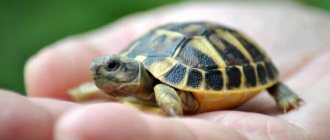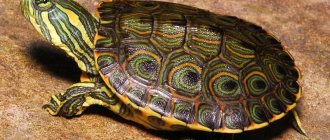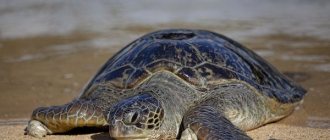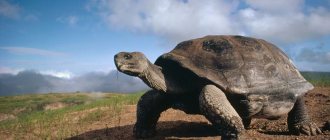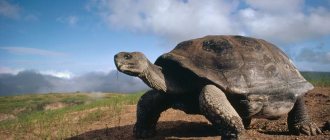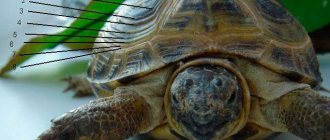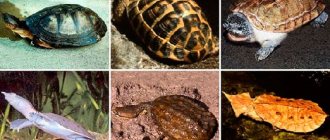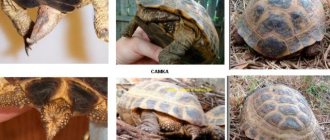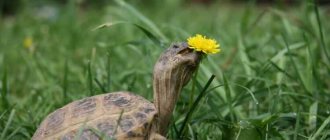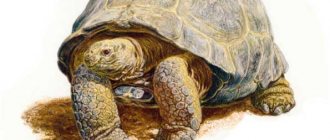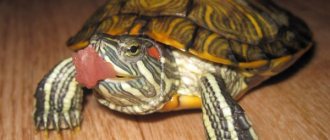Turtles are a large order belonging to the class of reptiles. The biological classification identifies more than 300 animal species, forming 14 families. An analysis of the fossil remains of the ancestors of modern turtles showed that the first representatives of the order appeared about 200 million years ago. During the existence of reptiles, their appearance has changed little, but the numbers of some species have reached critical levels in recent centuries. Currently, 228 species of turtles are listed in the International Red Book, half of them have the status of “endangered species”. The main factors influencing the population size include the capture of animals for food and jewelry, changing habitats and environmental pollution, and death as a result of an increase in the number of natural enemies.
Characteristics and description
Depending on their habitat, all turtles are divided into two large groups:
- marine;
- ground.
Land-dwelling species are also divided into land and river species.
Regardless of their lifestyle, all reptiles breathe oxygen. The respiratory organs of a sea turtle are the same as those of a land turtle. Since the ribs of animals are fixed in one position, the decrease and increase in lung volume occurs due to the muscles pulling the internal organs and then returning them back. At the same time, such a volume of oxygen can enter the lungs, which is enough for the animal to stay under water for several hours or even days. After this, the turtle rises to the surface for another breath.
Reptiles have a three-chambered heart, the spinal cord is very well developed, but the brain is not very large: it weighs only 1/1000 of the total mass of the animal.
Turtles lead a solitary lifestyle and are distinguished by a rather aggressive character, this behavior is especially evident in relationships with relatives.
What does it look like
The main external feature that distinguishes turtles from other reptiles is the presence of a shell. It consists of two parts: a convex carapace covering the back, and a flatter plastron located under the abdomen. In addition, the appearance of turtles has several more features:
- the head is slightly elongated and flattened on top, the eyes are located on the sides; in marine reptiles they are located in the upper part of the head;
- the animal has thick forelimbs and flatter hind limbs; in land turtles, the surface of the front paws is protected by dense scales; the paws of marine reptiles have transformed into flippers;
- Reptiles have a small tail; water-dwelling individuals use it for maneuvers.
Shell structure
In appearance, the shell looks like one continuous horny shield. In fact, it has a complex structure and is formed from 50 different bones by stretching and fusion of the ribs and vertebrae of the skeleton. If you look at the remains of fossil animals, you will see that the carapace on the inside resembles a rib cage located outside the body.
Many cartoons show how a turtle can freely leave its shell and return to it. This creates a false perception of the significance of the carapace and plastron for the reptile. In fact, these are parts of the turtle's skeleton, and without its shell it simply cannot survive. In addition, the horny plates have nerve endings and blood vessels, so damage to them causes pain to reptiles and can cause bleeding.
Most land turtles retract their heads by bending their necks into an S shape. Some species lay their necks sideways, pressing their heads against one of their forelimbs. Depending on this, secret-necked and side-necked turtles are distinguished.
Cheloniidae
(sea turtles). Five or six species of the family are large reptiles with limbs resembling oars or flippers. These are exclusively aquatic animals, coming ashore only to lay eggs or bask in the sun. It is very difficult for them to move on land. At least one species is found in all warm oceans.
The green (soup) turtle (Chelonia mydas) is the most famous of the sea turtles. It is distributed throughout the globe, and it is from it that the famous turtle soup is prepared. Previously, these reptiles were essentially mercilessly exterminated, often killing the females just before laying eggs.
Types of turtles with photos and names
Let's take a closer look at several families and varieties of marine and land reptiles.
American freshwater
A family of freshwater turtles, comprising more than 50 species. Medium-sized animals are found in South America and the south of the North American continent. Some species, such as the bog turtle, are widespread in Europe and Asia.
One of the smallest reptiles of the family is the spotted turtle: the length of its shell rarely exceeds 12 cm.
Red-eared
The most common inhabitant of home terrariums and aquariums. You can distinguish a red-eared slider by two red or yellow spots near the ears. Due to the different colors of the spots, there is also a second name - yellow-eared turtle. The shell and body are bright green with yellow and dark green stripes.
The reptile is a good diver and swimmer: the maximum speed of the red-eared turtle in water reaches 30 km/h.
Red-footed
Also known as the coal turtle. Lives in Central and South America. The shell of the cubs is light yellow in color; with age, it acquires a dark gray tint. The carapace is oval, slightly narrowed in the middle part. The forelimbs of the red-footed turtle are covered with many bright red and yellow spots.
Soft-bodied
The group includes several families, a characteristic feature of which is the absence of a hard horny shell. The upper part of the back of such reptiles is covered with a soft, leathery shell with a cartilaginous border. You can also recognize them by their elongated, nosed head. The most famous representatives of the group are the Trionics soft-bodied turtle, the narrow-headed turtle, and the Indian lobed turtle.
Leathery
It is the only species from the leatherback turtle family that has survived to this day. Characteristic features include the large size of the individuals (these are the largest reptiles of the entire order) and the structure of the shell, which is not connected to the skeleton and consists of small hard plates covered with skin.
Central Asian
Also known as the steppe tortoise. It has a noticeably convex shell of a sandy-brown color with dark spots in the centers of the horny scutes. The reptile continues to grow throughout its life. This is one of the most popular types for home keeping.
Just like the Mediterranean (Greek) tortoise, it belongs to land reptiles.
Bighead
You can recognize the reptile among other turtles by its long tail, as well as by the shape and size of its head: it widens significantly from the beak to the neck, and its length is equal to half the length of the carapace. Due to this body structure, the big-headed turtle is not able to hide in its shell.
Caspian
Lives in southern Europe. The shell is medium-sized and colored brown-green. The Caspian turtle is one of the few representatives of the order that can live in both fresh and salt water.
[edit] Origin
Archelon ischyros
This group appeared in the Triassic about 200 million years ago. It is possible that they appeared at the end of the Paleozoic. It is possible that turtles descended directly from cotylosaurs, the most primitive reptiles.
Although there are few fossils to support this hypothesis, the extinct genus Eunotosaurus is a good candidate for being an evolutionary link. This animal had a flattened body and greatly expanded ribs.
During evolution, many have adapted to life in continental reservoirs and seas.
They reached their greatest prosperity from the second half of the Mesozoic to the end of the Neogene. Previously, many genera and families were more widely distributed. For example, in Europe there lived soft turtles (side-necked, cayman, elephant and others), which are now preserved only on other continents.
Dimensions
The length of the shell and the weight of representatives of the order of turtles can vary greatly:
| Variety name | Shell length, cm | Weight, kg |
| Dermochelis | 250 | 600 |
| Sea green (soup) | 150 | 200 |
| Panther | 70 | 50 |
| Olive turtle | 60 | 45 |
| Cayman | 35 | 7 |
| Amazonian shieldfoot | 30 | 4 |
| Tuberous | 20 | 3 |
| Egyptian | 10 | 0,3 |
Classification
Turtle trainer. Painting by Osman Hamdi
- genus American land turtles ( Chelonoidis
) Coal turtle (
Chelonoidis carbonaria
) - Argentine tortoise ( Chelonoidis chilensis
) - Wood turtle ( Chelonoidis denticulata
) - Elephant turtle ( Chelonoidis elephantopus
)
)
- Brown turtle ( Manouria emys
)
)
)
- Star turtle ( Geochelone elegans
)
)
)
)
)
- Yellow-headed Indian turtle ( Indotestudo elongata
)
)
)
)
- Radiated turtle ( Astrochelys radiata
)
)
Giant tortoise (Aldabrachelys gigantea)
)
)
- Western desert gopher ( Gopherus agassizii
)
)
)
)
)
- Homopus boulengeri
Elastic turtle (Malacochersus tornieri)
)
)
- Spider turtle ( Pyxis arachnoides
)
)
)
- Geometric turtle ( Psammobates geometricus
)
)
)
)
- Banded tortoise ( Testudo marginata
)
)
)
)
)
- Serrated kinix ( Kinixys erosa
)
)
Central Asian tortoise (Agrionemys horsfieldi)
)
- †Rodriguez turtle ( Cylindraspis peltastes
)
)
- † Megalochelys atlas
Falconer & Cautley, 1844
Lydekker, 1889
What do they eat?
Land turtles are primarily vegetarians. They eat grass, fruits of bushes and trees, mushrooms and other plant foods. Aquatic reptiles are predators. The basis of their diet is small fish, amphibians, crayfish and mollusks.
This point is very important when keeping a turtle as a pet. Before decorative turtles settle in a terrarium or aquaterrarium, it is necessary to find out what a particular species eats in nature and adhere to the diet that is optimal for the pet.
Testudinidae
(land turtles). This family includes approx. 40 species of turtles found on every continent except Australia. This includes the relatively small Mediterranean tortoise (Testudo graeca), the giant elephant tortoise (Geochelone elephantopus) from the Galapagos Islands, and some bizarre African species. Thus, in African kinix tortoises (genus Kinixys), the back part of the carapace is movably connected to the front; the elastic tortoise (Malacochersus tornieri) from Tanzania and Kenya has a soft, flattened shell made of thin bony plates and can hide in narrow rock crevices in a moment of danger. The only members of this family found in the United States are in the genus Gopherus; they live in the southern part of the country.
In the 19th century Galapagos elephant tortoises were taken on whaling ships as supplies of meat for sailors. The capture of millions of individuals has undermined the population so much that it is in danger of extinction.
How do they reproduce?
The age of puberty depends on the size of the individuals. The smallest reptiles are ready to reproduce at 2 years of age; giant reptiles mature at 10-12 years and later. Regardless of the species and habitat conditions, turtle reproduction has several common features:
- during the mating season, skirmishes occur between males, during which rivals try to turn each other over or bite each other with a strong beak;
- before mating, males court females by stroking them with their forelimbs and making primitive sounds;
- all turtles are oviparous animals, the formation of eggs after fertilization occurs within 2-3 months, some females are able to retain the sex cells of the male in the body and make several repeated clutches per season;
- females choose places for laying so that the eggs warm up under the sun's rays; they dig holes for laying eggs themselves or use crocodile ones;
- The sex of the cubs is determined during the developmental stage and depends on temperature.
All turtles, with the exception of a few species, do not return to them after laying eggs and do not take part in protecting and raising their offspring. Turtles are born after 2-3 months; in larger species, the incubation process lasts up to six months. The hatched babies crawl towards the water. Many of them die, becoming food for birds of prey and animals.
Kinosternidae
(mud turtles). Turtles of this family, which includes 21 species, usually live at the bottom of rivers and lakes. The group's range extends from southeastern Canada through the central and eastern United States to South America. The eight species of mud turtles found in the United States have small, fleshy “whiskers” on their chins that help distinguish them from other members of the order.
The most famous member of the family, the common musk turtle (Sternotherus odoratus), is common in the waters of the eastern United States. Its length does not exceed 13 cm, but it greatly annoys local fishermen, as it often gets hooked, and when it is picked up, it secretes a stinking secretion from the musk glands. In addition, she is warlike and bites painfully.
Trailing turtles (genus Kinosternon) are found almost exclusively in the southeastern United States. They avoid deep bodies of water and come to land from time to time. The range of the Pennsylvania turtle (Kinosternon subrubrum) extends from the southeast of the country along the Atlantic coast to the southwestern tip of Connecticut.
Does a turtle have teeth
The oral cavity of turtles of all varieties is structured almost the same: biting and grinding food is carried out with the help of rhamphothecae. These are reduced teeth that have taken the form of horny sheaths covering the edges of the jaws. On the surface of the rhamphothecae there are irregularities and roughness, which crush solid food. Thanks to the horny plates, the turtle's mouth resembles a beak. This structure of the oral cavity is also characteristic of some other orders of reptiles.
JELLYFISH
[edit] Systematics
The origin and evolution of turtles (narrated by Dmitry Pashchenko)
Order Turtles (Testudines) (Linnaeus, 1758)
contains about 250-300 modern species, grouped into 13 families.
→ Types of turtles
- family Asian river turtles (Bataguridae) +
- family Two-clawed turtles (Carettochelyidae) Boulenger, 1887 +
- family Snake-necked turtles (Chelidae) Gray, 1825 +
- family Sea turtles (Cheloniidae) Oppel, 1811 +
- family Cayman turtles (Chelydridae) Gray, 1831 +
- family Mexican turtles (Dermatemydidae) Gray, 1870 +
- family Leatherback turtles (Dermochelyidae) Fitzinger, 1843 +
- family American freshwater turtles (Emydidae) Rafinesque, 1815 +
- family Mud turtles (Kinosternidae) Agassiz, 1857 subfamily Kinosterninae +
- subfamily Staurotypinae +
Interesting facts about turtles
- The smallest turtle in the world is the Cape flat turtle. It lives in the south of the African continent. The length of the shell of adult individuals does not exceed 9-10 cm. The average weight of the animal is 240 grams.
- The speed of movement of a reptile largely depends on the weight and temperature of the environment. The slowest are giant turtles, covering no more than 4 km per hour, and the fastest are sea turtles, capable of swimming at speeds of up to 35 km/h.
- The rarest turtle in the world is the Fernandina turtle. In 2022, an adult female belonging to this species of giant tortoise was discovered on one of the Galapagos Islands. Previously, Fernandina turtles were considered extinct.
- Turtles live the longest of all vertebrates. There is a large number of documented facts that many of these reptiles lived to be 100-150 years or more. The oldest turtle in the world is Jonathan, who lives on St. Helena Island. In 2022, the reptile turns 187 years old.
- The Madagascar radiated tortoise is recognized as the most beautiful representative of the order. You can recognize it by the yellow color of its body and the unusual coloring of its carapace: numerous light stripes extend from the center to the edges of each scute.
Believe in yourself
[edit] Literature
- Biological encyclopedic dictionary." Ch. ed. M. S. Gilyarov; Editorial team: A. A. Babaev, G. G. Vinberg, G. A. Zavarzin and others - 2nd ed., corrected. - M.: Sov. Encyclopedia, 1986.
- Collier's Encyclopedia. — Open society. 2000.
- Biology. Modern illustrated encyclopedia. Ch. ed. A. P. Gorkin; M.: Rosman, 2006.
- N. B. Ananyeva, N. L. Orlov, R. G. Khalikov, I. S. Darevsky, S. A. Ryabov, A. V. Barabanov “Atlas of reptiles of Northern Eurasia (taxonomic diversity, geographic distribution and conservation status) » Zoological Institute of the Russian Academy of Sciences, St. Petersburg, 2004
- Brem A., Animal Life, 4th ed., vol. 5, St. Petersburg. 1914
| Homemade | Aquarium fish • Canary • Dwarf rabbit • Cat • Rat • Guinea pig • Parrots • Dog • Hamster • Turtle |
| Exhibition | Pigeon • Mute swan • Peacock |
| Mammals | Alpaca • Buffalo • Camel • Goat • Cow • Rabbit • Llama • Horse • Hinny • Mule • Sheep • Deer • Donkey • Pig • Elephant • Yak |
| Birds | Goose • Turkey • Chicken • Muscovy duck • Quail • Ostrich • Duck • Pheasant • Guinea fowl |
| Insects | Cochineal • Bee • Silkworm (oak • mulberry) |
In most turtles, temperature during incubation determines the sex of the hatchlings.
In species with “temperature-dependent sex determination,” temperature during the second third of incubation influences the biochemical development that determines the sex of the hatchling. Two developmental models have been described for turtles. Type I species have a narrow core temperature range (usually between 27-32°C), above which only females are produced and below which only males are produced. Type II species have two main temperature ranges, with males predominant at intermediate temperatures and females at both extremes of the range.
Photo: www.news.wjct.org
Sex determination appears to be genetically determined in Austro-American side-necked turtles, all soft-bodied turtles and some musk and pond species. Among them, only the wood turtle, two species of giant musk turtles, the black marsh turtle and the brown turtle have dimorphic sex chromosomes; all others have the same chromosome sizes in males and females.
Notes
- Darevsky I. S., Orlov N. L.
Rare and endangered animals. Amphibians and reptiles: Ref. manual / ed. V. E. Sokolova. - M.: Higher School, 1988. - P. 54. - 463 p., l. ill. — 100,000 copies. — ISBN 5-06-001429-0. - Falconer H. and Cautley PT 1844. Communication on the Colossochelys atlas
, a fossil tortoise of enormous size from the Tertiary strata of the Siwalk Hills in the north of India.
Proceedings of the Zoological Society of London 1844
(12): 54–84. - Lydekker R. 1889. Catalog of the Fossil Reptilia and Amphibia in the British Museum. Part III. Chelonia. London: British Museum of Natural History, 239 pp.
| This is a draft article on herpetology. You can help the project by adding to it. |
Stress? No, we haven't heard
Not only can turtles be considered the oldest group of reptiles, but they can also adapt to extreme environmental conditions. For example, the western painted turtle survives in the complete absence of oxygen in the body and partial freezing during hibernation [16]. It simply controls the process of production and consumption of ATP molecules [17]!
And the relatively slow pace of molecular evolution of globins helped her in this [18]. The globin superfamily arose 400 million years ago [19]. There are currently eight known types of globins that can be found in different vertebrates. It is surprising that turtles are still the only known vertebrates with a complete repertoire of globins (Fig. 8). This phenomenon allows for a comparative analysis of the expression of all eight globins in one form. This is necessary for an in-depth study of the functions of these proteins and the resistance of turtles to oxygen starvation.
Different types of globins differ in structure, function and evolutionary history. The known hemoglobins (Hbs) and myoglobins (Mbs) serve to transport and store O2. However, globins also have other functions and may be involved in the production and degradation of nitric oxide, detoxification of reactive oxygen species, or intracellular signaling.
Figure 8. Distribution of globins among vertebrates
[18], figure adapted
There are three types of globins that not everyone has:
- globin X (GbX) is a membrane-bound globin in the nervous system, not found in birds or mammals;
- the functions of globin Y (GbY) are quite difficult to determine, since the features of its synthesis and its taxonomic distribution have not yet been sufficiently studied, although it is known that it is absent in most mammals;
- globin E (GbE) - participates in the processes of oxidative metabolism in the retina, found only in birds and some reptiles.
The loss of some globin genes may be explained in part by physiological changes when the need for a particular globin disappears or is replaced by another molecule, as well as by random changes in the genome.
Dietary preferences vary widely among the turtle family
Turtles' diet ranges from completely herbivorous to completely carnivorous; however, many turtles consume a mixture of plant and animal foods. Some species show a transition from a carnivorous diet in hatchlings to a predominantly herbivorous lifestyle in adults.
Although modern turtles do not have teeth, there are many modifications to the maxillary, premaxillary, and dentary bones for feeding. The pronounced keratin beak can be used to hold and tear food. The palate of herbivorous turtles contains a number of ridges that help macerate plant matter. Macrocephaly, characterized by an enlarged head (as in many female map turtles), often develops in shellfish-eating species. Wide crushing surfaces and powerful muscles allow them to consume plentiful food that may not be available to turtles, which cannot extract this food from the protective shell of the mollusk.
Photo: Christian Miller
